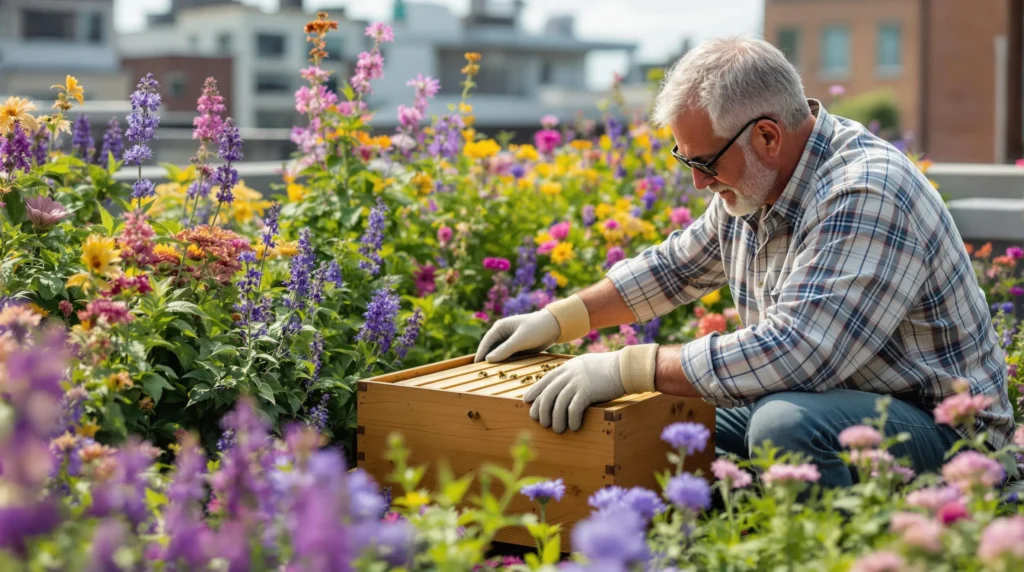Why Rooftop Beekeeping Gardens Are Buzzing with Popularity
Rooftop beekeeping gardens have gained tremendous momentum in urban areas for compelling reasons. These elevated sanctuaries address critical environmental challenges while offering tangible benefits to practitioners. Urban beekeeping contributes significantly to pollinator conservation, with each hive supporting approximately 50,000 bees that can pollinate plants within a three-mile radius. The economic advantages are equally impressive—a well-maintained hive typically produces 30-60 pounds of honey annually, creating opportunities for local, sustainable products. Beyond the practical benefits, rooftop apiaries transform underutilized spaces into vibrant ecosystems, improving property values by up to 7% according to recent real estate studies. They also serve as educational platforms, connecting city dwellers with nature’s processes and promoting environmental awareness. As urban farming initiatives continue to expand, rooftop beekeeping stands out as a particularly efficient use of space—requiring as little as 10 square feet for a basic setup while delivering maximum ecological impact.
Essential Elements for Creating a Successful Rooftop Beekeeping Garden

A thriving rooftop beekeeping garden requires careful planning and attention to key components. Creating the perfect environment for your bees will ensure their health and productivity while maximizing the benefits for your urban network.
Selecting the Right Beehive Types for Urban Environments
For rooftop settings, Langstroth hives offer ideal versatility with their stackable design that allows for expansion as your colony grows. These vertical hives occupy minimal space—typically just 2×2 feet at the base—making them perfect for limited rooftop areas. Top-bar hives present an excellent alternative for beginners, requiring less heavy lifting and providing easier honey harvesting without specialized equipment. If aesthetics matter to your rooftop garden, consider Flow Hives with their modern design and innovative honey collection system that minimizes disturbance to the bees. Always choose hives made from durable, weather-resistant cedar or pine treated with bee-safe sealants to withstand urban rooftop conditions.
Weather Protection and Windbreak Answers
Rooftop environments expose bees to intensified weather conditions that ground-level apiaries don’t face. Install windbreaks using strategically placed potted shrubs like boxwood or juniper positioned 3-4 feet from hives to buffer strong gusts without blocking flight paths. For temperature regulation, consider creating partial shade with pergolas or shade cloth that blocks 30-40% of sunlight during peak summer heat. Position hives with entrances facing southeast to provide morning warmth while protecting from afternoon heat. During winter, wrap hives with insulation boards or commercial hive wraps, leaving ventilation points open to prevent moisture buildup. Elevate hives 6-8 inches on stands to protect from water accumulation after heavy rains—crucial for preventing hive damage and disease.
Water Sources for Your Buzzing Friends
Bees require consistent access to water for both hydration and hive temperature regulation, consuming up to a gallon per day in summer for a healthy colony. Create safe drinking stations using shallow dishes filled with clean water and floating cork pieces or marbles that provide landing platforms to prevent drowning. Maintain multiple water sources at different heights around your rooftop garden, placing them 10-15 feet from hives to encourage foraging behavior while reducing congestion near the colony. Consider installing self-filling water features with solar-powered pumps that ensure continuous supply even during your absence. Add small amounts of sea salt to one water source—approximately ¼ teaspoon per gallon—to provide essential minerals that support bee health and nutrition throughout the active season.
7 Space-Saving Garden Designs for Rooftop Beekeeping
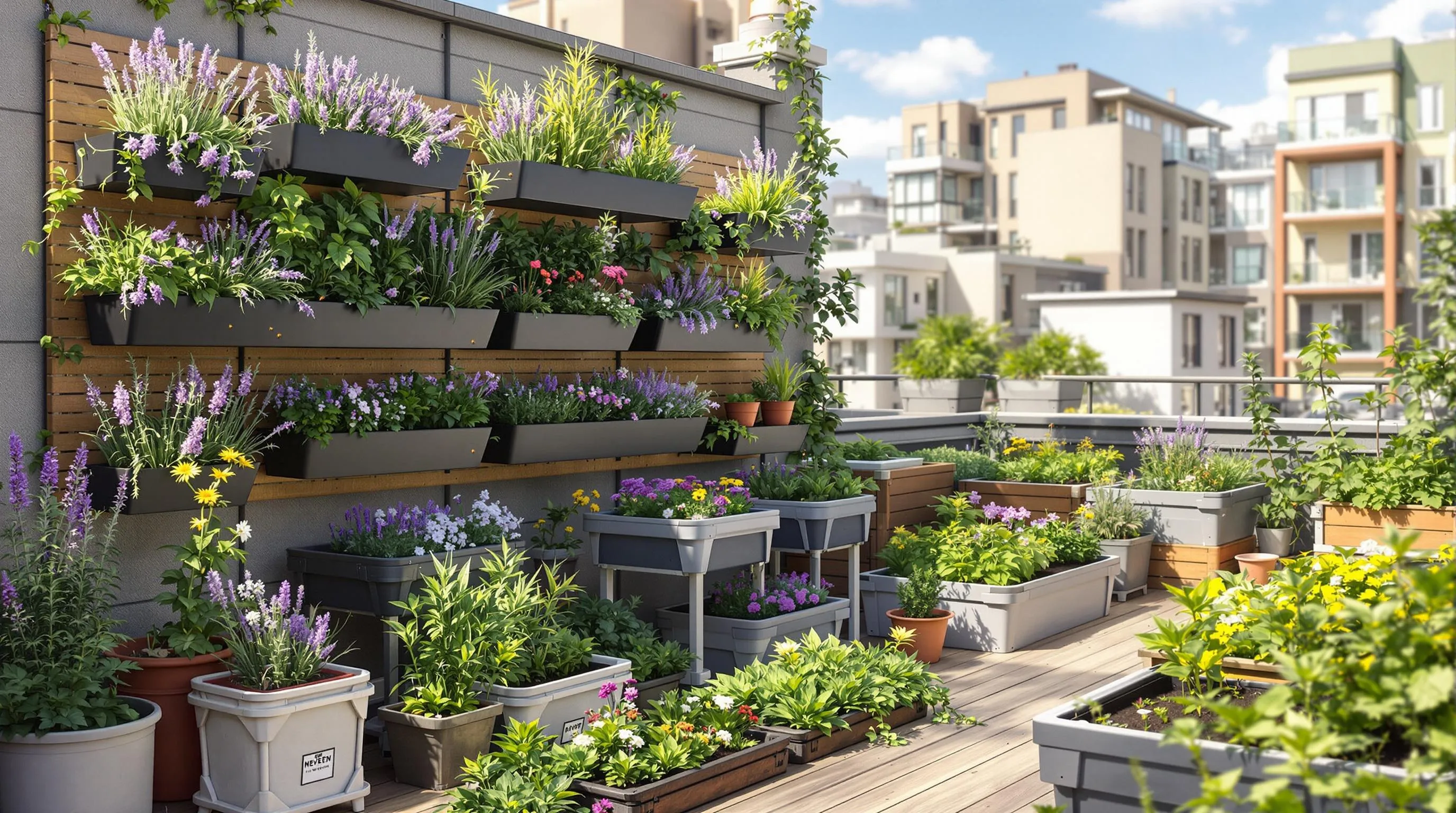
Limited rooftop space doesn’t mean limiting your beekeeping dreams. These innovative garden designs maximize every square inch while creating the perfect environment for your bees to thrive.
Vertical Garden Installations
Vertical gardens transform your rooftop’s unused vertical space into thriving bee havens. Install wall-mounted planters, pallet gardens, or specialized vertical growing systems that can accommodate a variety of bee-friendly plants. These space-efficient answers can create a green wall containing lavender, rosemary, and thyme—all excellent nectar sources that bees love. A standard 6×8-foot vertical garden can support up to 32 different plant varieties while occupying minimal floor space, keeping pathways clear for hive maintenance. For added efficiency, incorporate irrigation systems with timers that water your vertical garden automatically, reducing your maintenance workload.
Container Gardens with Bee-Friendly Plants
Container gardens offer unmatched flexibility for rooftop beekeepers, allowing you to arrange, rearrange, and optimize your space as needed. Select weather-resistant containers in various sizes—from compact 8-inch pots for herbs to larger 24-inch planters for flowering shrubs. Group containers by watering needs, placing drought-tolerant plants like echinacea and Russian sage together to streamline maintenance. Stack containers on tiered plant stands or repurposed shelving to maximize vertical space. The mobility of container gardens also provides a important advantage: you can easily move plants around to create seasonal windbreaks for your hives or adjust sun exposure as the seasons change. Choose lightweight, weather-resistant materials like fiberglass or high-quality plastic to minimize roof load.
Modular Garden Systems
Modular garden systems provide a customizable framework that grows with your beekeeping journey. These interlocking units—typically square or rectangular growing beds—can be arranged in countless configurations to fit your exact rooftop dimensions. Start with a basic setup of 2-3 modules near your hives, then expand as space and experience allow. Each 4×4-foot module can support 16 different plant varieties when using square-foot gardening techniques, maximizing biodiversity in minimal space. The standardized design makes seasonal rotation simple, allowing you to swap out spring-flowering modules for summer-blooming varieties to ensure continuous forage for your bees. Many modular systems also incorporate built-in water reservoirs, reducing watering frequency and providing emergency water sources for your bees during hot weather.
10 Best Pollinator-Friendly Plants for Rooftop Bee Gardens
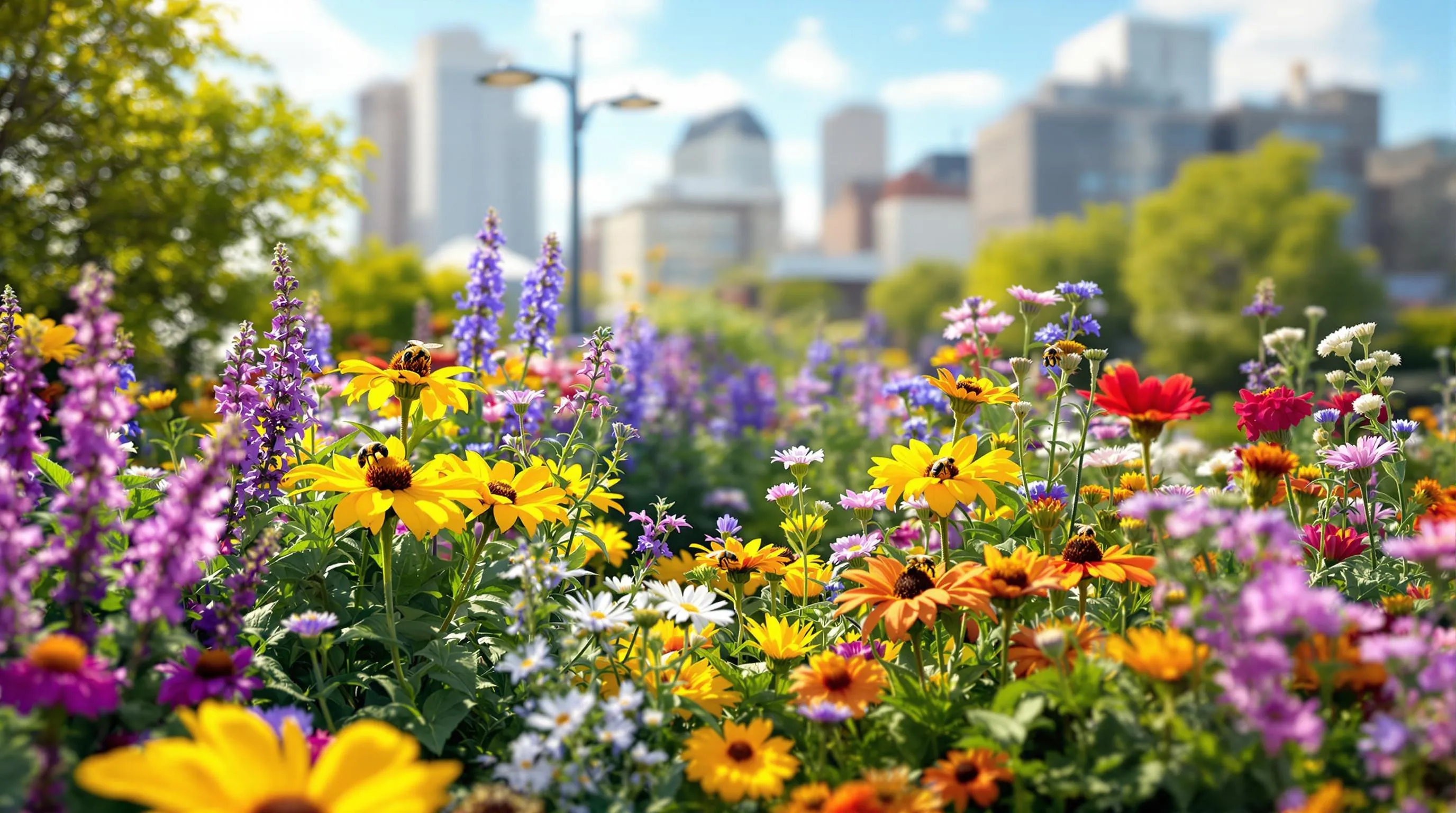
Creating a thriving rooftop bee garden requires selecting plants that provide abundant nectar and pollen throughout the growing season. These top pollinator-friendly plants will transform your urban rooftop into a bee paradise while adding beauty and biodiversity to your space.
Spring Bloomers for Early Nectar Sources
Kickstart your bee garden with early-season bloomers that provide critical nutrition when bees emerge from winter. Crocus bulbs offer one of the first food sources in February-March, with their vibrant purple and yellow flowers rich in pollen. Pair these with cheerful Lungwort (Pulmonaria), which produces nectar-filled blue and pink flowers even in partial shade conditions. Chives deliver dual benefits—their purple pom-pom blooms attract countless pollinators while providing fresh herbs for your kitchen. Include native Serviceberry (Amelanchier) for its delicate white spring blossoms that support over 35 bee species and require minimal maintenance in container environments.
Summer-Long Flowering Varieties
Maintain constant nectar flow during peak bee activity with summer-blooming powerhouses. Lavender thrives in rooftop conditions, requiring minimal water while providing aromatic purple flower spikes that bees travel miles to visit. Compact varieties like ‘Munstead’ need just 12 inches of growing space. Borage stands out with its striking blue star-shaped flowers that refill with nectar every two minutes, making it a bee magnet from June through September. Incorporate Black-eyed Susans (Rudbeckia) for their extended blooming period and pollen-rich centers that support specialist bee species. Russian Sage offers drought-tolerance and months of lavender-blue flowers, perfect for hot, exposed rooftop conditions while requiring minimal water once established.
Fall Plants to Support Late-Season Foraging
Extend your bee garden’s productivity with fall bloomers that help bees prepare for winter. Sedum ‘Autumn Joy’ provides crucial late-season resources with its flat, pink flower heads that serve as landing pads for dozens of pollinators simultaneously. This succulent thrives in shallow containers and withstands rooftop heat. Asters produce masses of daisy-like flowers in September-October when other plants have finished blooming, with each plant supporting over 20 bee species. Add Goldenrod for its brilliant yellow flower spikes that bloom until frost—contrary to popular belief, it doesn’t cause allergies but does provide essential pre-winter protein for bees. Complete your seasonal succession with Autumn Crocus, which requires minimal space while delivering unexpected fall blooms that extend nectar availability well into October.
Sustainable Practices for Eco-Friendly Rooftop Apiaries
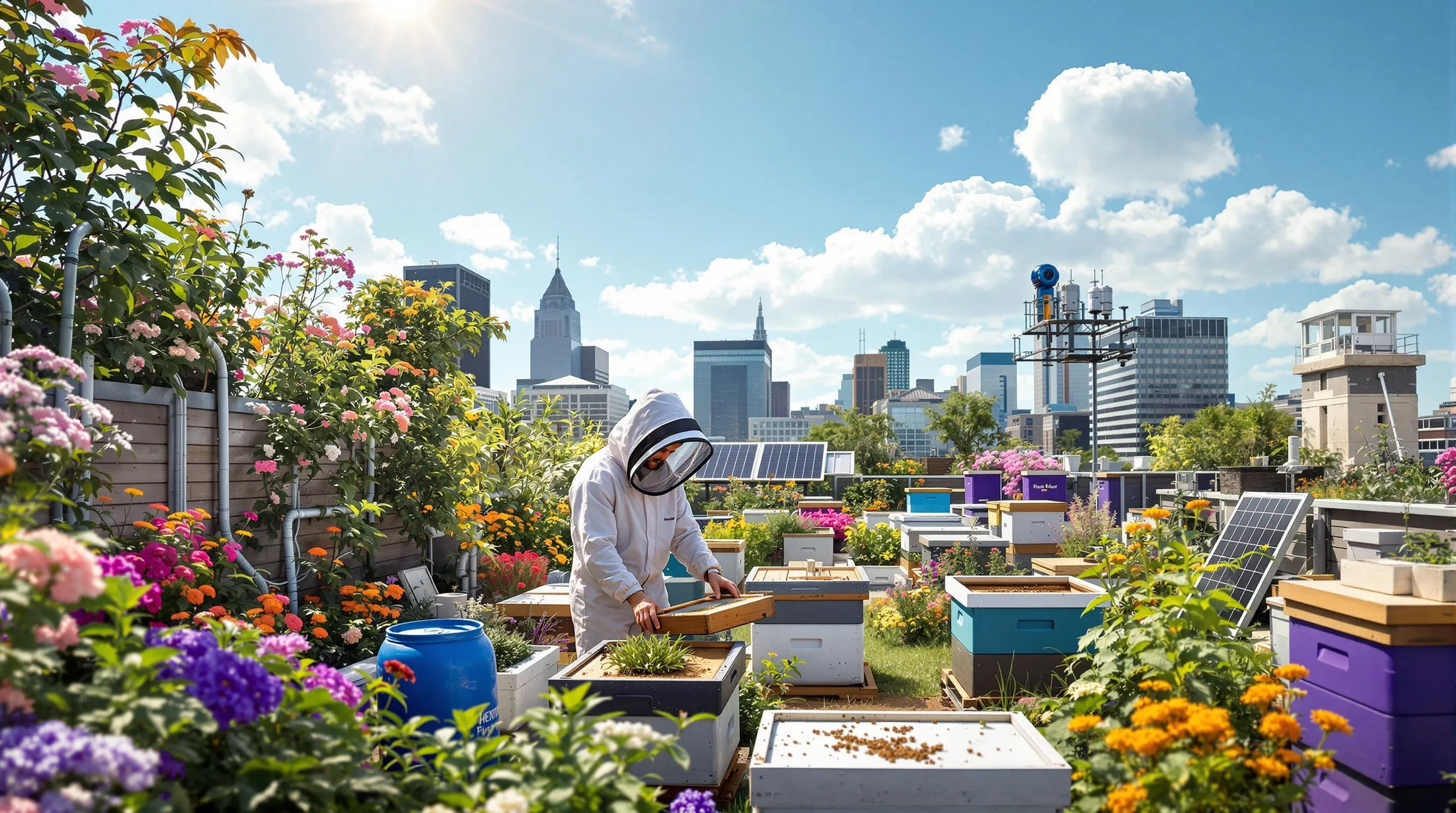
Transforming your rooftop beekeeping garden into a sustainable network requires implementing eco-friendly practices that minimize environmental impact while maximizing benefits for your bees and plants. These sustainable approaches not only reduce your carbon footprint but also create a more resilient and self-sufficient apiary system.
Rainwater Collection Systems
Capture free, chemical-free water for your bees and plants by installing rainwater harvesting systems on your rooftop. Rain barrels connected to downspouts can collect up to 50 gallons of water during a single rainfall, providing ample reserves for dry periods. Install mesh filters at collection points to prevent debris contamination and mosquito breeding. For more sophisticated setups, consider gravity-fed drip irrigation systems that deliver water directly to your plants, reducing waste by up to 70% compared to traditional watering methods. Your bees will benefit from shallow dishes filled with collected rainwater, complete with floating cork or wood pieces that serve as landing platforms to prevent drowning.
Solar-Powered Beekeeping Equipment
Harness the sun’s energy to power your beekeeping operations with solar technology that’s perfectly suited for exposed rooftop environments. Solar-powered observation hive lighting allows for nighttime hive checks without disturbing bees with flashlights. Install small solar panels (as compact as 12″×12″) to power electric fencing that deters pests like raccoons and mice from approaching your hives. Solar-powered monitoring systems track hive temperature, humidity, and weight, sending real-time data to your smartphone to help detect swarming behavior or health issues before they become critical. These systems typically require only 5-10 watts of power, making them highly efficient for rooftop use where sunlight exposure is optimal.
Composting Answers for Rooftop Gardens
Create a closed-loop system by implementing compact composting answers that turn organic waste into nutrient-rich soil for your rooftop garden. Vermicomposting bins, measuring just 2’×3′, can process up to 5 pounds of kitchen scraps weekly while producing worm castings that boost plant immunity and flowering. Bokashi fermentation systems allow for rapid pre-composting of all food waste including meat and dairy in sealed buckets, perfect for space-limited rooftops. The resulting compost tea serves as a powerful natural fertilizer, reducing your dependence on store-bought products while providing your bee-friendly plants with balanced nutrition. Position your composting station in a partially shaded area of your rooftop to maintain optimal decomposition temperatures and prevent odor issues during hot summer months.
Creative Honey Harvesting Stations for Limited Spaces

Even with minimal rooftop space, you can create efficient honey harvesting stations that maximize productivity while maintaining a small footprint. Wall-mounted extraction systems save valuable floor space by utilizing vertical areas for honey processing equipment. These compact units typically include an uncapping tray, small extractor, and bottling station all in one integrated system. Folding workstations offer another space-saving solution, allowing you to extend your honey processing area only when needed and fold it away when not in use. For ultra-compact setups, consider multi-functional furniture pieces that serve as both seating and storage for honey harvesting tools during the off-season. Mobile cart systems equipped with wheels provide flexibility to move your harvesting station to optimal positions on your rooftop or even indoors during inclement weather. By incorporating these space-conscious designs, you’ll create an efficient honey harvesting workflow without sacrificing precious rooftop garden space.
Combining Beekeeping with Urban Vegetable Gardens
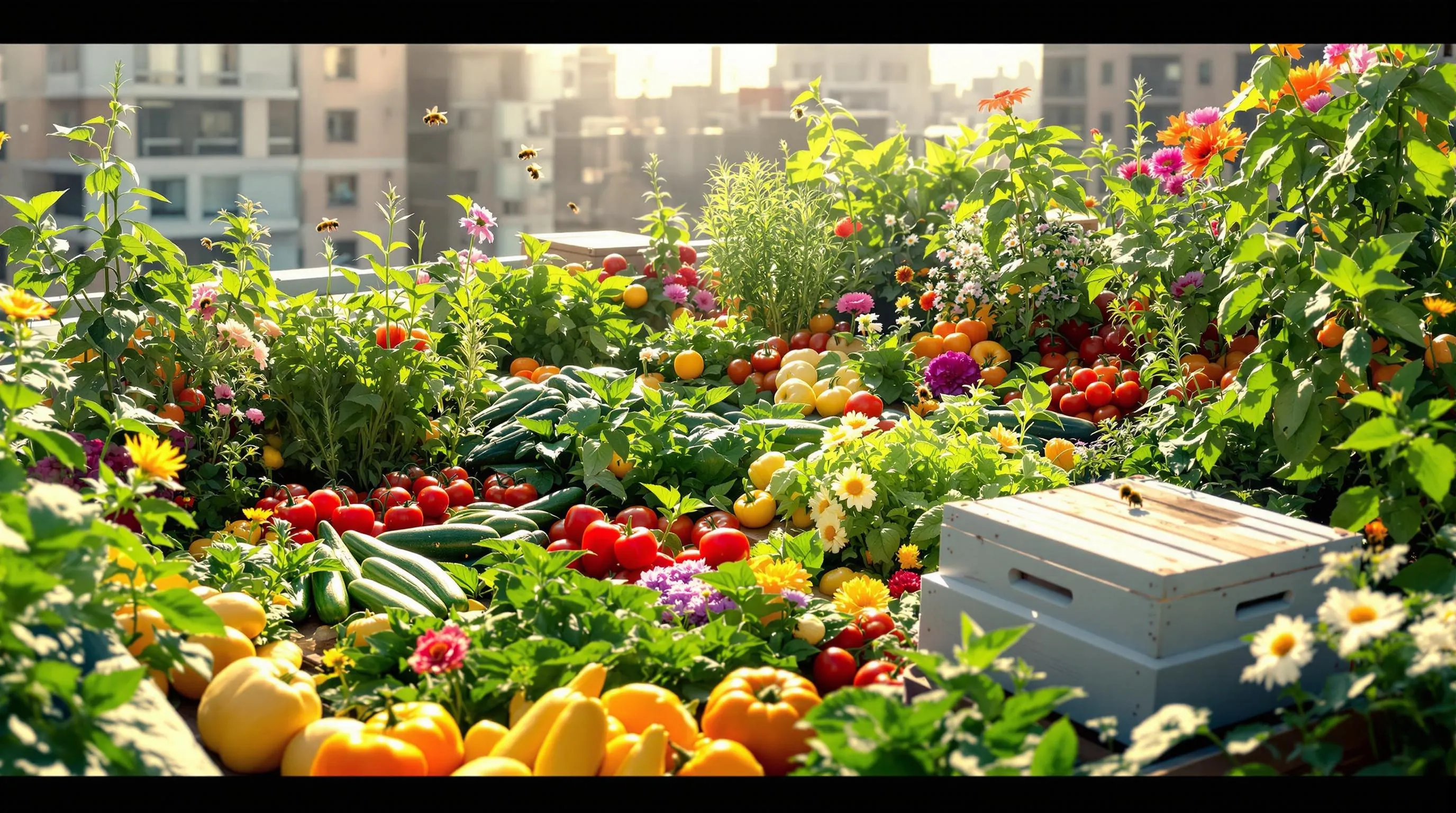
Creating a symbiotic relationship between your beehives and vegetable garden maximizes your rooftop’s productivity while supporting local ecosystems. Bees provide essential pollination services that can increase vegetable yields by up to 30%, while your vegetables offer diverse foraging options for your honeybees. Position your hives at the edge of your rooftop garden, facing southeast to encourage early morning activity and place them at least 6 feet from your primary gardening areas to avoid disrupting bee flight paths. Select companion vegetables like squash, cucumbers, tomatoes, and peppers that benefit significantly from bee pollination. Incorporate herbs such as basil, thyme, and rosemary between vegetable rows to provide additional nectar sources while repelling common garden pests. Install raised beds with proper drainage systems to ensure optimal growing conditions without compromising your roof’s structural integrity. Use organic growing practices exclusively, as chemical pesticides can harm your bee population and contaminate honey production. This integrated approach creates a self-sustaining rooftop network where bees and vegetables thrive together, maximizing your urban space’s ecological and productive potential.
Legal Considerations and Community Relations for Urban Beekeepers
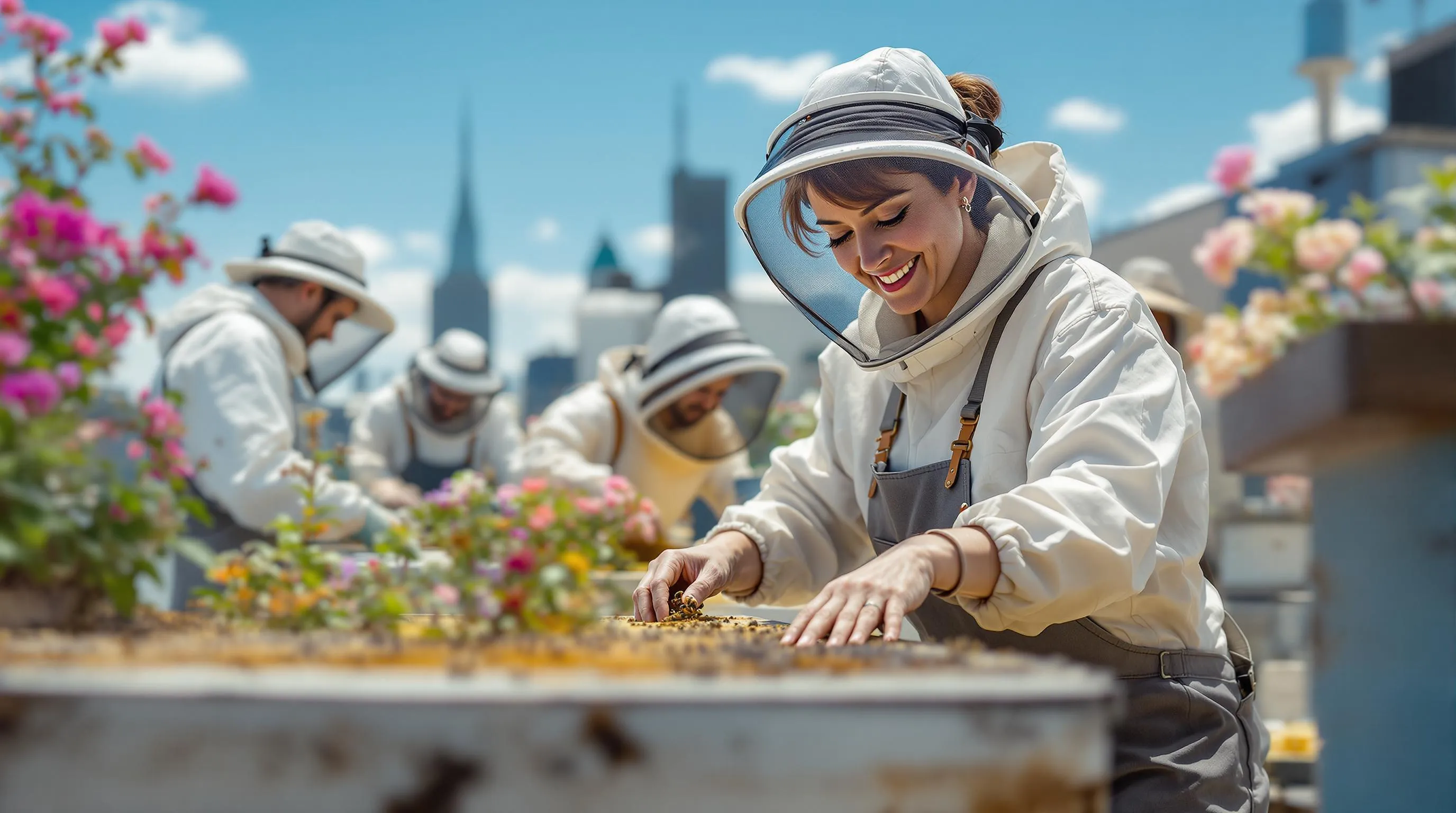
Before establishing your rooftop beekeeping garden, you’ll need to navigate local regulations and build positive community relationships. Most urban areas have exact ordinances governing beekeeping—check with your local Department of Agriculture or city planning office to understand permit requirements, hive number limitations, and setback rules. Many cities limit hives to 2-3 per property and require them to be positioned at least 10-15 feet from property lines. Registration with local beekeeping authorities is often mandatory, costing between $20-50 annually. You’ll also need liability insurance (approximately $300 yearly) to protect against potential incidents. Building positive relationships with neighbors is equally important—consider hosting educational events, sharing honey as goodwill gestures, and clearly posting contact information near your apiary. When choosing hive locations, prioritize spots that minimize bee flight paths over common areas. Responding promptly to any concerns and joining local beekeeping associations will help ensure your urban beekeeping project thrives while maintaining community support.
Year-Round Maintenance Tips for Thriving Rooftop Bee Gardens
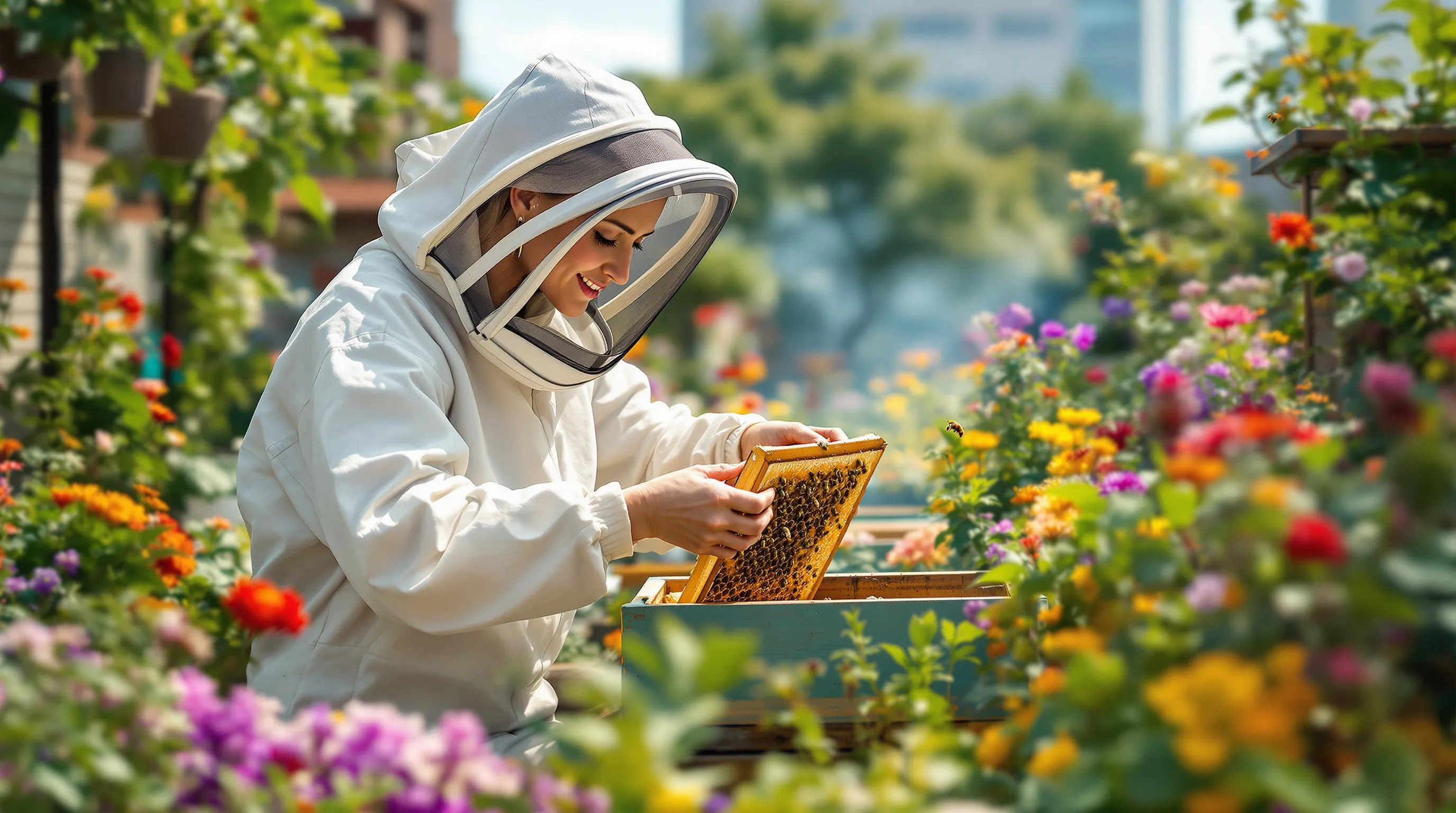
Maintaining a rooftop bee garden requires consistent attention throughout the seasons to ensure both plants and pollinators thrive. In spring, focus on inspecting your hives after winter dormancy and replacing any damaged components while planting early-blooming varieties like crocuses and lungwort. Summer demands regular watering schedules—ideally in early mornings—and monitoring for pests such as varroa mites, which you can control using organic methods like powdered sugar dusting. Fall maintenance includes preparing hives for colder temperatures by adding insulation materials and reducing entrance sizes to prevent drafts. During winter, clear snow accumulation from hive entrances and periodically check honey stores, supplementing with sugar syrup if reserves run low. Year-round, maintain detailed records of hive inspections, blooming cycles, and honey production to identify patterns and improve your management practices. Remember that seasonal maintenance isn’t just about survival—it’s about creating optimal conditions for your bees to flourish across all four seasons in their unique rooftop environment.
From Hive to Table: Enjoying the Fruits of Your Rooftop Beekeeping Garden
Your rooftop beekeeping garden represents a perfect harmony between urban living and natural systems. By creating this elevated sanctuary you’ve joined a growing movement that’s making our cities greener and more sustainable.
The benefits extend far beyond the honey you’ll harvest. You’re now part of the solution to declining pollinator populations while creating a vibrant network that transforms underutilized space into a productive haven.
Remember that your rooftop apiary is always evolving. As your confidence grows you can expand your plant selection optimize your space and refine your beekeeping techniques. The journey from novice to experienced urban beekeeper is rewarding at every step.
Start small think big and watch as your rooftop transforms into a buzzing oasis that nourishes both bees and your connection to nature.

